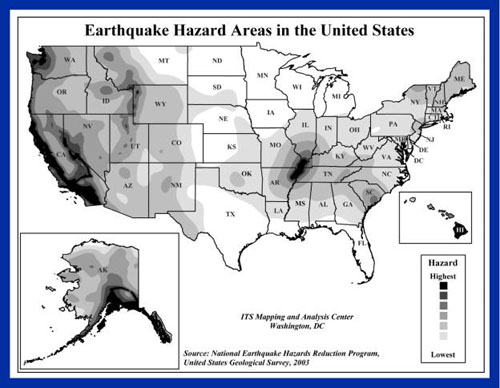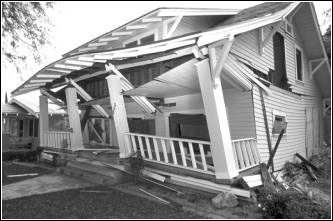
One of the most frightening and destructive phenomena of nature is a severe earthquake and its terrible aftereffects. An earthquake is a sudden movement of the earth, caused by the abrupt release of strain that has accumulated over a long time.
For hundreds of millions of years, the forces of plate tectonics have shaped the earth, as the huge plates that form the earths surface slowly move over, under, and past each other. Sometimes, the movement is gradual. At other times, the plates are locked together, unable to release the accumulating energy. When the accumulated energy grows strong enough, the plates break free. If the earthquake occurs in a populated area, it may cause many deaths and injuries and extensive property damage.
Know the Terms
Familiarize yourself with these terms to help identify an earthquake hazard:
Earthquake A sudden slipping or movement of a portion of the earths crust, accompanied and followed by a series of vibrations.
Aftershock An earthquake of similar or lesser intensity that follows the main earthquake.
Fault The fracture across which displacement has occurred during an earthquake. The slippage may range from less than an inch to more than 10 yards in a severe earthquake.
Epicenter The place on the earths surface directly above the point on the fault where the earthquake rupture began. Once fault slippage begins, it expands along the fault during the earthquake and can extend hundreds of miles before stopping.
Seismic Waves Vibrations that travel outward from the earthquake fault at speeds of several miles per second. Although fault slippage directly under a structure can cause considerable damage, the vibrations of seismic waves cause most of the destruction during earthquakes.
Magnitude The amount of energy released during an earthquake, which is computed from the amplitude of the seismic waves. A magnitude of 7.0 on the Richter Scale indicates an extremely strong earthquake. Each whole number on the scale represents an increase of about 30 times more energy released than the previous whole number represents. Therefore, an earthquake measuring 6.0 is about 30 times more powerful than one measuring 5.0.
Take Protective Measures
Before an Earthquake
The following are things you can do to protect yourself, your family, and your property in the event of an earthquake:
- Repair defective electrical wiring, leaky gas lines, and inflexible utility connections. Get appropriate professional help. Do not work with gas or electrical lines yourself.
- Bolt down and secure to the wall studs your water heater, refrigerator, furnace, and gas appliances. If recommended by your gas company, have an automatic gas shut-off valve installed that is triggered by strong vibrations.
- Place large or heavy objects on lower shelves. Fasten shelves, mirrors, and large picture frames to walls. Brace high and top-heavy objects.
- Store bottled foods, glass, china, and other breakables on low shelves or in cabinets that fasten shut.
- Anchor overhead lighting fixtures.
- Be sure the residence is firmly anchored to its foundation.
- Install flexible pipe fittings to avoid gas or water leaks. Flexible fittings are more resistant to breakage.
- Locate safe spots in each room under a sturdy table or against an inside wall. Reinforce this information by moving to these places during each drill.
- Hold earthquake drills with your family members: Drop, cover, and hold on!

During an Earthquake
Depending on where you are, different actions are necessary to be as protected as possible. Here are different scenarios and what you should do if you are:
Indoors:
- Take cover under a sturdy desk, table, or bench or against an inside wall, and hold on. If there isn't a table or desk near you, cover your face and head with your arms and crouch in an inside corner of the building.
- Stay away from glass, windows, outside doors and walls, and anything that could fall, such as lighting fixtures or furniture.
- Stay in bed - if you are there when the earthquake strikes - hold on and protect your head with a pillow, unless you are under a heavy light fixture that could fall. In that case, move to the nearest safe place.
- Use a doorway for shelter only if it is in close proximity to you and if you know it is a strongly supported, loadbearing doorway.
- Stay inside until shaking stops and it is safe to go outside. Most injuries during earthquakes occur when people are hit by falling objects when entering into or exiting from buildings.
- Be aware that the electricity may go out or the sprinkler systems or fire alarms may turn on.
- DO NOT use the elevators.
Outdoors:
- Stay there.
- Move away from buildings, streetlights, and utility wires.
In a moving vehicle:
- Stop as quickly as safety permits and stay in the vehicle. Avoid stopping near or under buildings, trees, overpasses, and utility wires.
- Proceed cautiously once the earthquake has stopped, watching for road and bridge damage.

Trapped Under Debris:
- Do not light a match. Do not move about or kick up dust.
- Cover your mouth with a handkerchief or clothing.
- Tap on a pipe or wall so rescuers can locate you. Use a whistle if one is available. Shout only as a last resort - shouting can cause you to inhale dangerous amounts of dust.
After an Earthquake
- Be prepared for aftershocks. These secondary shockwaves are usually less violent than the main quake but can be strong enough to do additional damage to weakened structures.
- Open cabinets cautiously. Beware of objects that can fall off shelves.
- Stay away from damaged areas unless your assistance has been specifically requested by police, fire, or relief organizations.
- Be aware of possible tsunamis if you live in coastal areas. These are also known as seismic sea waves (mistakenly called tidal waves). When local authorities issue a tsunami warning, assume that a series of dangerous waves is on the way. Stay away from the beach.
For More Information
If you require more information about any of these topics, the following are resources that may be helpful.
FEMA Publications:
Avoiding Earthquake Damage: A Checklist for Homeowners. Safety tips for before, during, and after an earthquake
Preparedness in High-Rise Buildings. FEMA-76. Earthquake safety tips for high-rise dwellers
Learning to Live in Earthquake Country: Preparedness in Apartments and Mobile Homes. L-143. Safety tips on earthquake preparation for residents of apartments and mobile homes
Family Earthquake Safety Home Hazard Hunt and Drill. FEMA-113. How to identify home hazards; how to conduct earthquake drills
Earthquake Preparedness: What Every Childcare Provider Should Know FEMA 240. Publication for teachers and for presentation to children.
 Print
Print Email
Email







